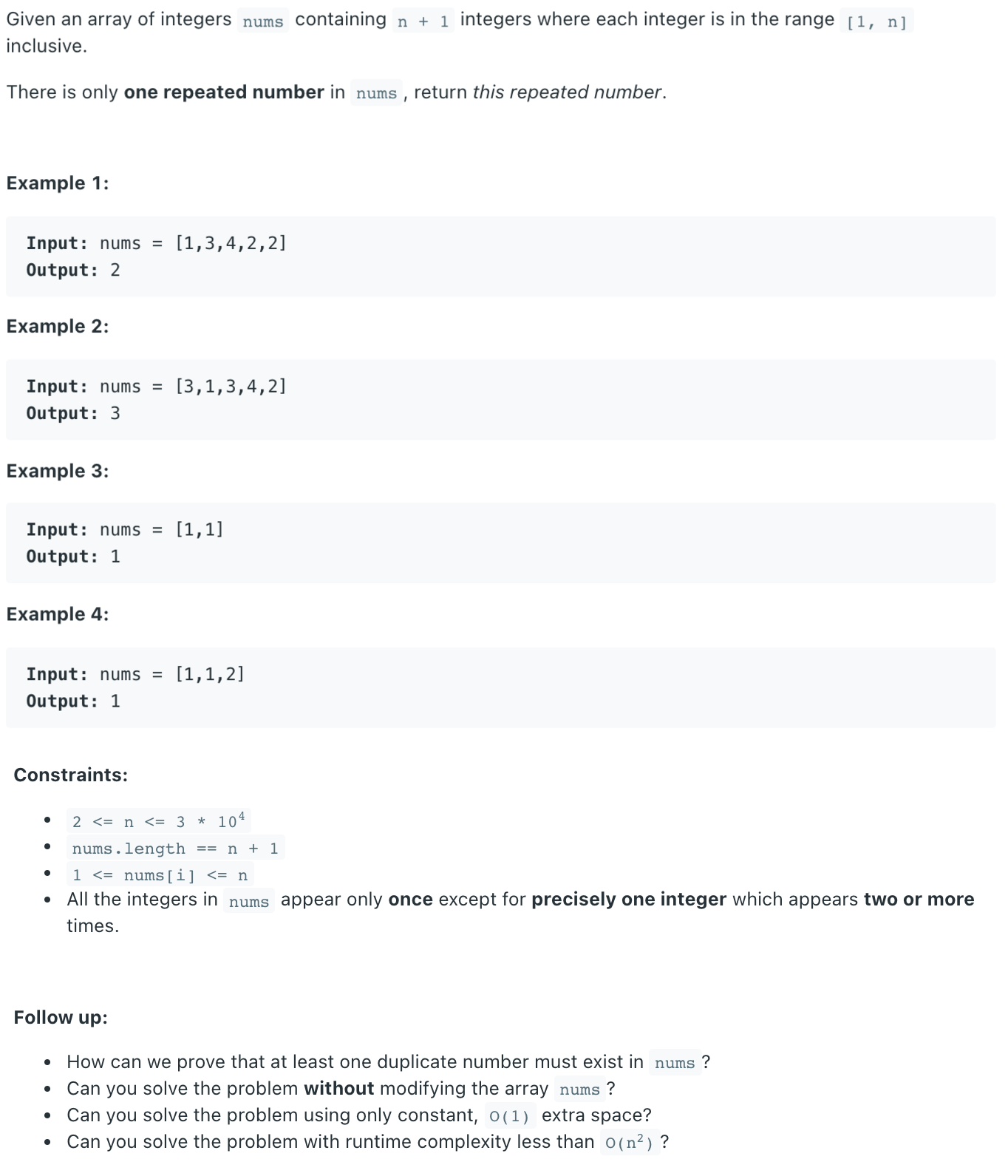Find the Duplicate Number

# Solution
See more at this LeetCode post (opens new window).
# Built-in Types
# Counter
Complexity
time:
space:
def findDuplicate(self, nums: List[int]) -> int:
cnt = Counter(nums)
return max(cnt, key=cnt.get)
2
3
# Sorting
Complexity
time:
space:
def findDuplicate(self, nums: List[int]) -> int:
n = len(nums)
nums.sort()
for i in range(1, n):
if nums[i] == nums[i-1]:
return nums[i]
2
3
4
5
6
7
# Set
Complexity
time:
space:
def findDuplicate(self, nums: List[int]) -> int:
hashset = set()
for num in nums:
if num in hashset:
return num
hashset.add(num)
2
3
4
5
6
# Follow Up
How can we prove that at least one duplicate number must exist in nums?
Proving that at least one duplicate must exist in nums is simple application of the pigeonhole principle (opens new window). Here, each number in nums is a "pigeon" and each distinct number that can appear in nums is a "pigeonhole". Because there are numbers are distinct possible numbers, the pigeonhole principle implies that at least one of the numbers is duplicated.
Can you solve the problem using only extra space?
# Binary Search
cnt[i] represents number of elements in nums <= i
Say the duplicate is , then all elements in [1, target-1] satisfy cnt[i]<= i, and all elements in [target, n] satisfy cnt[i] > i.
Thus, use binary search to find according to the monotone cnt.
Complexity
time:
space:
def findDuplicate(self, nums: List[int]) -> int:
n = len(nums)
res = 0
left = 1
right = n-1
while left <= right:
mid = (left + right) >> 1
cnt = 0
for i in range(n):
if nums[i] <= mid:
cnt += 1
if cnt <= mid:
left = mid + 1
else:
right = mid - 1
res = mid
return res
2
3
4
5
6
7
8
9
10
11
12
13
14
15
16
17
18
19
# Bit Mask
For the ith bit, there are elements in nums[1..n] having it as , and there are elements in [1.n] it as . The has the ith bit as iff .
Complexity
time:
space:
def findDuplicate(self, nums: List[int]) -> int:
n = len(nums)
res = 0
bit_max = 31
while not (n - 1) >> bit_max:
bit_max -= 1
for bit in range(bit_max+1):
x = y = 0
for i in range(n):
if nums[i] & 1 << bit:
x += 1
if i>=1 and i&(1<<bit):
y += 1
if x > y:
res |= 1 << bit
return res
2
3
4
5
6
7
8
9
10
11
12
13
14
15
16
# Floyd's Cycle-Finding Algorithm
Form a graph against nums. Every index has an edge . As there exists a duplicate , so at least 2 edges point to such a target. Thus, the graph has a cycle and is the entrance of the cycle.
See more at the similar problem Linked List Cycle II.
Complexity
time:
space:
def findDuplicate(self, nums: List[int]) -> int:
n = len(nums)
fast = slow = nums[0]
# do-while loop
while True:
slow = nums[slow]
fast = nums[nums[fast]]
if slow == fast:
break
# find the entrance to the cycle
fast = nums[0]
while slow != fast:
fast = nums[fast]
slow = nums[slow]
return fast
2
3
4
5
6
7
8
9
10
11
12
13
14
15
16
17
18